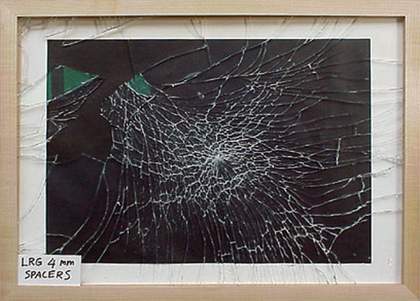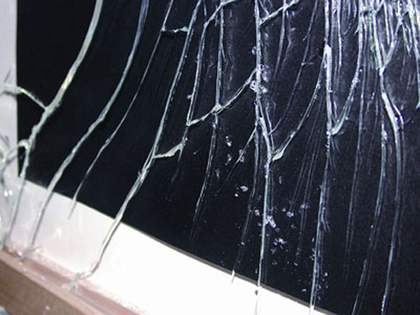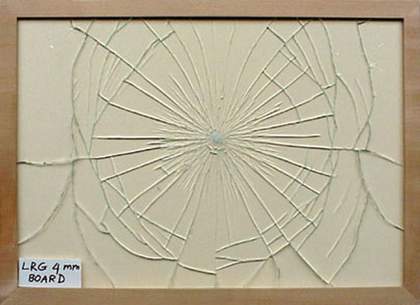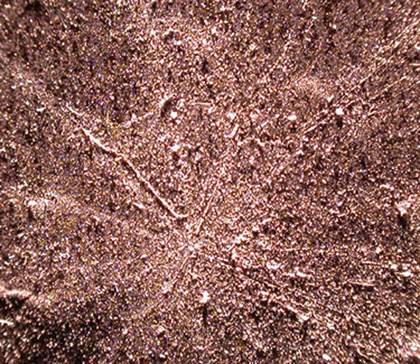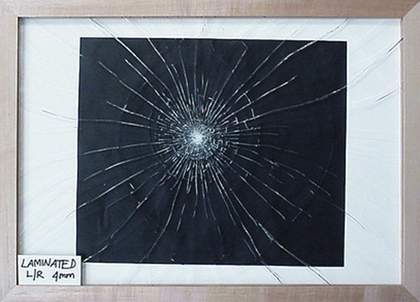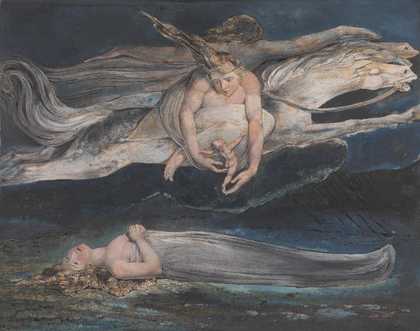
William Blake
Pity (c.1795)
Tate
Several years ago the Conservation Department at Tate prepared works for a remarkable display of late Turner oil paintings and watercolours at Tate Liverpool, celebrating the artist’s abstract depictions of light and air.1 In an effort to gain the full effect of these shimmering paintings and in a manner unconventional for Tate works, all the oils were displayed without their habitual frames and glazing.2 Standard house frames were rejected for works on paper and the watercolours and oil sketches were shown unframed, resting on sloped supports in old-fashioned vitrines or framed behind low reflective glass. As a result, Turner’s works could be appreciated without the distortions and reflections of the omnipresent layer of acrylic or glass which I had come to take for granted when viewing works on paper framed for display, loan, or exhibition.
The experience drew my attention to the aesthetic compromises frequently made when works of art are glazed, especially works on paper. This paper examines the wide variety of factors including safety, cost, and physical and optical properties which must be weighed up when selecting a glazing material. Building on existing internal research on glazing and framing for artworks at Tate, this article also looks at current glazing practice in that museum, and presents the results of further tests which have been recently conducted on the glazing materials used there.
Glazing
In selecting the most appropriate glazing for works of art on paper, or indeed for any work of art, the safety of the work itself is paramount. In light of the continuous improvement being made to the physical and optical properties of glass and plastics, combined with improved museum practice and safer art transport, the suitability of certain glazing products should be re-assessed. Glazing helps protect the artwork from touching, impacts, spillage and other physical accidents; dust and dirt, pollution, microbiological hazards; environmental extremes; and, in some cases, ultraviolet light. However, it is seen by most conservators and curators as a necessary evil and any advantages must be offset against well known disadvantages such as reduced visibility (including reduced light transmission, reflections, colour casts, distortions); potential breakage and damage to the artwork; additional weight, cost and labour involved; possible structural or aesthetic unsuitability of the frame; and other issues such as static, condensation and thermal instability. There may also be ethical concerns to take into account such as conflicts regarding the artist’s intent and/or the desires of art owners or curators. The decision to glaze a work of art may sometimes be in conflict with the desires of curators or owners, or in opposition to the intent of the artist and how he/she understands the work should be presented. If glazing is judged to be desirable for the long term well being of an artwork, it is essential that the conservator is aware of all the options available before making a case for glazing and selecting the appropriate material.
Glazing options
Several valuable articles have been published in recent years on glazing options for works of art, their advantages and disadvantages.3 The choice of glazing still remains one of either glass or plastic but the range of properties offered by these products is continually widening. Both glass and acrylic are now available in modified versions which provide low-reflective, colourless and ultra-violet (UV) light-protecting properties (fig.1).
1. Glass
Compared to the relatively recent phenomenon of glazing paintings, the value of protecting vulnerable works on paper with a glazing layer has long been recognised. Works on paper have been displayed behind glass since the seventeenth century and the survival of many historic works on paper is due in large part to the protection offered to them by this humble material. The main advantages of glass are that it has good clarity, is non-static, and relatively durable, stable and cheap. However, it can be inflexible and brittle, difficult to handle and heavy.4 Ordinary float glass is reflective, can give colour casts and may be thermally unstable.5 It is breakable and may not break in a safe manner, often shattering in irregular cracks which form knife-edged shards and dangerous loose pieces. Old antique glass is valued for the very properties we generally aim to avoid in modern glass, such as colour casts, imperfections and planar distortions. It tends to be thin and can behave unpredictably. If the decision is made to retain old glass in a frame, every precaution should be taken to ensure it is not subjected to breakage.
In early attempts to make glass more resistant to breaking, laminated glass and toughened or tempered glass were developed. Toughened or tempered glass (such as the glass used in windscreens) is substantially stronger than ordinary float glass and laminated glass. The glass sheet, which is cut to size before treatment, is strengthened by heating then quickly cooled. However, the process can only be used on thick pieces of glass which are usually inappropriately heavy for glazing artworks. In the event of breakage with sufficient force, toughened/tempered glass will disintegrate into pieces which can cause substantial damage to an artwork. The use of this type of glass has generally been superseded by laminated glass. As discussed below, the optical properties of toughened and laminated glass vary dependent on their manufacture. Both types can be produced to provide exceptional clarity, but toughened/tempered glass tends to have a colour cast due to its thickness.
Toughened glass has been used on occasion in the past as glazing for Tate works, most often for large works going on loan. Besides its heaviness, another disadvantage is that sheets need to be custom-made to size making it expensive.
Laminated glass is made by bonding two sheets of glass together with a clear, semi-flexible layer of resin adhesive such as poly (vinyl butyral). Laminated glass is not substantially stronger than single-sheet glass of a comparable thickness: its major advantage is its safe breaking mode. When breakage occurs, the laminating resin layer holds the glass shards in place and creates a more confined, regular pattern of cracking.
2. Plastics
The inclusion of methacrylate monomers in laminating resins for glass in the early 1930s led to the discovery by Rohm and Haas of acrylic plastic sheet. From the 1970s onward the relatively wide availability of plastics for use as a glazing alternative caused a revolution in framing. Acrylic, poly (methyl methacrylate), polystyrene, and polycarbonate are now known under a number of trade names and are available with various properties. Polycarbonate and polystyrene are generally thought to be inferior to good quality acrylic in colour, clarity and long term stability: the main advantages of these two products are their availability in larger sizes and their ease of cutting and handling. Polycarbonate (eg. Lexan®) is the most resistant of the three to breaking and scratching. Acrylic (e.g. Perspex™, Plexiglass®, Acrylite®) is the most commonly known and used. Its introduction has run parallel with the world wide acceleration of exhibition schedules, touring shows, and national and international loans. As in many museums and galleries around the work, works on paper (and paintings) being prepared for travel by Tate have been routinely re-glazed with acrylic and standard display frames are fitted with it. Lightweight, flexible, relatively easy to cut and handle, and with ultraviolet protecting versions becoming widely available in the 1970s, acrylic is also considered a safer option than ordinary float glass.
Plastics, however, are by no means unbreakable and they do not always break in a safe manner. Glazing impact tests carried out informally in the Conservation Department at Tate revealed that acrylic sheet was more vulnerable to impact than glass and the broken acrylic could, in some cases, create extremely sharp, jagged wedges which could easily damage an artwork. In their unmodified forms, plastics also have a vulnerable surface, are highly reflective, static and they can suffer from colour casts and lack of clarity. Acrylic can react to the off-gassing of uncured paints and printing inks by the formation of fogging or very fine crazing in the glazing sheet. Large sheets flex and bow, causing distortions for the viewer and possible difficulties keeping the glazing surface away from the work. Large sheets are also known to expand and contract in response to extreme temperature changes.
In many cases, however, acrylic is eminently suited to the task, it is good for glazing multiple small, light-coloured, sturdy works easily, safely and cheaply. Owing to its flexibility and lightness, it also lends itself to the glazing of works in large, lightweight frames which are too flexible to support glass although distortions may become a problem and availability of sheets over three metres in length can be difficult.
Glazing properties
The properties desirable in glazing products used for works of art include good strength and surface durability, high breakage threshold and safe breaking mode, good image clarity, negligible colour cast, low reflectance, ultraviolet protection, workable weight and thickness, low levels of static and long term stability. The order of importance of these properties and therefore the type of glazing selected will be dictated by many factors, including the appearance of the work, its vulnerability, the strength and size of frame, the cost, and necessity for the glazing to filter out ultraviolet light.
1. Ultraviolet protection
Ultraviolet protection is not present to any notable degree in ordinary float glass or plastic glazing products. Protection is achieved during manufacture either by applying a surface coating to the glazing which excludes harmful wavelengths or by including ultraviolet absorbing properties within the glazing material itself. Both glass and plastic glazing are available with ultraviolet protecting capabilities. Some types of ultraviolet protecting plastics have a slight yellowish cast because they work by absorbing a little of the violet/blue end of the visible spectrum. The resin adhesive layer in laminated glass also usually acts as an ultraviolet inhibitor.
Logically, ultraviolet protection is only of value where ultraviolet light is not controlled at recommended levels. However, as the consequences of ultraviolet exposure can be severe for works on paper, it is advisable to use glazing with ultraviolet protection wherever there is any doubt about the quality of light the work may be exposed to. In practical terms, ultraviolet protective glazing enables artwork to be displayed where lighting is not or cannot be filtered at source.
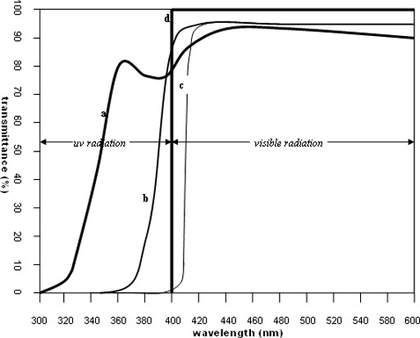
Fig.2
Graph showing examples of transmissions of
a) standard window glass transmitting high levels of ultraviolet radiation,
b) colourless ultraviolet absorbing glass transmitting reduced levels of ultraviolet radiation,
c) ultraviolet absorbing acrylic transmitting very low levels of ultraviolet radiation plotted against
d) ideal ultraviolet filter (with no radiation of wavelengths shorter than 400nm transmitted and maximum levels of visible radiation transmitted)
© Tate 2005
When purchasing new ultraviolet protective glazing materials, it is recommended to obtain relevant transmission curves from the manufacturer (fig.2). Products with the least amount of radiation below 400nm and the maximum amount of visible light transmission should be selected.6 Ultraviolet protection may deteriorate with time and therefore glazing should be examined and tested every five to ten years with a ultraviolet meter and a known source of ultraviolet such as unfiltered daylight or fluorescent tubes (fig.3).
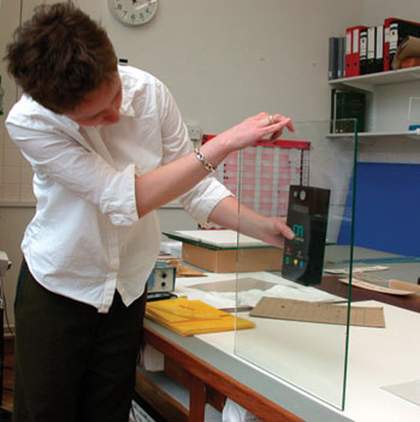
Fig.3
Testing ultraviolet protection of glazing sheet using a meter and natural light
© Tate 2005
2. Colour and clarity
The colour cast of glazing products can be quite noticeable, especially when the glazing lies over a light coloured artwork. Colour variations can become visible when two works are framed in different glazing materials and hung close to each other. Ordinary float glass has a green tinge, caused by iron impurities or iron oxide additives in its make-up. As mentioned above, some ultraviolet absorbing or filtering products have a yellow tinge which can also darken with age. Plastics are sometimes colour-adjusted to grey or green, which also diminished clarity. Obviously, any tint which compromises the viewing of the artwork should be avoided. Colourless glass, often called water white glass (WW) has either low iron content or a component (such as manganese) added to offset the green colouration. Relatively colourless acrylics with high ultraviolet protection and good resistance to yellowing, such as Plexiglass® GS 231, are also now more easily available. Wherever possible, colourless products should be selected in preference to tinted versions.
3. Reflectivity
Ordinary float glass and plastic glazing can create distortions and specular reflections. The problem is exacerbated on darkly coloured works, as well as by poor display lighting. In particular, works under standard glazing displayed along corridors, in large rooms, or where there are bright spots and windows on opposite walls suffer from visually disturbing reflections. Low reflective glass (LR) should be a consideration when the extent of reflection using standard glass or acrylic is unacceptable where static may be a problem, and where it is an affordable option.
Reflectivity is reduced either by etching the glazing surface (these products are often referred to as anti-glare) or by applying coatings to it (low-reflective or anti-reflective products). Etching creates a rough surface which increases the diffuse scatter of light. Etched glass often has to be in direct contact with the artwork to avoid making the image out of focus and it is therefore unsuitable for museum quality glazing.
Anti-reflective coatings applied by dipping were developed by Schott in the 1930s but did not begin to be used in the museum world until much later. In 1964 Schott launched Mirogard® Standard, an ordinary float glass with a low reflective coating. Coated low reflective glass came into general use in the mid-1980s, followed later by low reflective glazing with ultraviolet protection and laminated versions. Low reflective glass is made by applying optical interference coatings made from thin layers of metallic oxides to both sides of the glazing surface, increasing the transmission of light whilst reducing the level of reflectivity, in some cases to less than 1% (as opposed to approximately 8% reflectivity for ordinary float glass). High quality low reflective glass has extremely good clarity and light transmission but because the interference effect is dependent on wavelengths, it gives off green or violet reflections when viewed at oblique angles. These can be visually distracting but are considered a small price to pay for virtual invisibility of the glazing layer when viewed face on and correctly lit.
Acrylic has higher reflectance levels than ordinary float glass and this is probably its greatest drawback. Until recently, low reflective plastics have only been available in an etched version and have therefore been unacceptable for museum glazing. Recently, an abrasion resistant acrylic with a titanium based low reflective coating and good ultraviolet filtration has become available, marketed as OptiumTM by Viratec in the USA and by TruVue® in the UK. It is an extremely effective low reflective glazing with a high level of clarity and light transmittance. According to conservators using this product, it also exhibits lower than usual static charge.7 It is expensive but fills a gap that has existed in the market for a product with many of the advantages of both glass and acrylic.
4. Strength / breakage thresholds
Two major factors when assessing glazing (especially for works travelling) are the resistance of the glazing to breakage and the type of break which occurs when the glazing is damaged. Any glazing product is going to be vulnerable at some point, as the triple laminated unbreakable glass in front of the Leonardo cartoon belonging to the National Gallery proved when it was damaged by a shotgun blast in 1987.8 It is worth noting, however, that damage from impact to an artwork would usually be far greater without the presence of glazing, whether it breaks or not. Every conservator is concerned about using breakable glass as a glazing for artworks, despite the fact that if works are framed, handled, stored and displayed to a high standard, the risk of breakage is extremely small.
At Tate, there have been very few instances of glass breakage recorded over many years. During the three years it took to transfer Tate Collections to a new store there were no incidents of damage to works, let alone glass breakage, a credit to the safe handling and transportation procedures employed.9
Obviously, glazing breakage is dependent on many variables and combinations of variables, including the manner of accident and the type of frame and glazing. This makes it impossible to predict categorically how certain glazing will react when an accident occurs. One bump on a frame rebate can cause even relatively thick glass to shatter from a light impact in the right place. Broken glass and acrylic are both capable of causing serious damage to a work but may also cause little or no damage. The degree to which a work of art is damaged by broken glazing is also dependent on what happens after the damage has taken place. The tests results discussed below should be interpreted with these points kept in mind.
Tate tests on glazing strength
In the early 1990s Tate paintings conservators carried out a range of tests on glazing, framing and the efficiency of the museum’s packing and casing standards.10 Tests were initially carried out on frames of various sizes, with different types of glazing, packed and crated to the museum’s specifications. The results of those tests established primarily that ordinary float glass from Tate stock is much stronger than was generally expected when high standards of framing and casing are consistently applied. Glass fitted in frames and cases to Tate specifications was found to be intact after rigorous impact and shock tests. This reassuring result was due in large part to the strength and integrity of the frames, and also the effectiveness of the custom made crates. As a result of these tests, the one-metre rule was introduced, suggesting a maximum width or height of one metre as the threshold for deciding when laminated glass should be fitted in appropriate frames and crates.
Further experimentation on glazing and frame strength has been recently carried out on Tate standard sized frames for works on paper, focusing on their flexibility and impact resistance. The results reinforced earlier findings and confirmed they were also applicable to frames for works on paper; well-fitted glass in rigid frames with stiff, sealed backing boards showed remarkable resistance to breaking. Sample frames were prepared as follows: A range of the museum’s standard-size oak and maples frames (half-royal, imperial, A0) were glazed with 4 mm thick low reflective glass which was taped into the frame rebate using a low tack self adhesive tape.11 Waxy black paper was hinged into the sample frames to simulate artwork and reveal any damage which occurred. The frames were fitted with spacers or window mounts, back mounts and hardboard backboards held with framers’ points and sealed with gummed paper tape.
Flexibility tests were carried out by applying increasingly heavy weights to the long or short edge of each frame and measuring the degree of deflection caused. These tests revealed that Tate frames could withstand a similar amount of flexing either lengthwise or width wise but were twice as easy to flex on the diagonal and were therefore more likely to cause glass breakage when flexed in this direction. Large frames (A0) were found to be more rigid than small (half-royal) ones. The greater cross-sectional area of the moulding of larger frames reduced flexing in the lengthwise and width wise directions. Further investigation could be carried out into the possible reduction of flexing on the diagonal by improving the strength of the frames’ corner joints.
Impact tests were carried out by swinging a suspended weight into the centre of a glazed frame, gradually increasing the force of the blow until the glazing broke. The glazing resisted impact much more than observers had predicted. These tests produced some other interesting results. Most notably, the area of contact of the mount with the glass was important, affecting its breakage threshold and causing different types of break to occur. More force was required to break glass in a frame fitted with a 9 mm wide spacer (giving a 6 mm deep gap between the glass and the artwork’s surface) than in frames where no spacer or mount was provided. Glass framed in full contact with the mount board broke the most easily. This suggested that the pocket of air created in a frame fitted with spacers allowed for greater deflection in the glass. The glazing with spacers, however, broke in a more random pattern than either the sample with a window mount or the frame with the glazing in contact with a solid sheet of mount board. The glazing with spacers broke spectacularly, with uneven sprays of cracks running across the glass surface and pieces of glass breaking off and dropping down to the frame rebate, which could cause serious damage to an artwork (figs.4 and 5). The presence of mount board against the glazing created a more controlled, cobweb shaped radial break and held the broken pieces in place, therefore restricting the damage sustained more or less to the point of impact (fig.6). The more glass area in contact with the mount board, the more controlled the breakage tended to be (fig.7). With each breakage, the quantity of glass dust and tiny shards embedded in the test object at the epicentre of the break varied. Even on the cleanest break, the amount of glass dust was substantial when the impact area was examined under magnification (fig.8). Impact tests carried out on frames fitted with laminated glass (4.4 mm thick) and on acrylic (3 mm) showed similar results to the breakage thresholds of the 4 mm thick single sheet glass, with the acrylic proving to be slightly more resistant to breaking. As mentioned above, the laminated glass broke in a safe manner with even radial cracks which remained in place and the point of impact did not even make contact with the surface of the test object (fig.9). In the case of the acrylic glazing, impact caused only two irregular, large cracks across the entire glazing surface. However, these broken areas had dangerously sharp edges which could have cut the surface of the work and would cause serious damage if the broken glazing was wedged against it (fig.10).
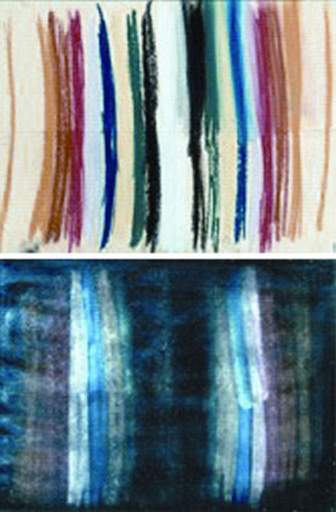
Fig.11
Pastel sample (above) and offset on glass after glass tape has been removed (below)
Photography courtesy of Heather Norville Day and Tim Green © Tate 2005
Taping glass
Taping of glass has long been an accepted precaution against damage from breakage for works of art being prepared for travel. However, the results of testing carried out by Tate in the early 1990s on taped glazing suggested that this practice did not consistently reduce the degree of damage sustained by artworks when the glazing broke.12 If the breakage was caused by a certain type of impact, the jagged pieces of glass were still easily able to cause considerable damage, especially if the tape was incorrectly applied. Additionally, carelessly applied and removed glass tape can easily damage glazing and frames and cause serious damage to artworks containing friable media because of static charge (fig.11).13 14 It should always be kept in mind that theoretically glazing is most at risk during handling after the tape has been removed and before the work is hung.
However, there may be cases where taping is a valid precaution such as works travelling without crates, oversize works, pieces in non-standard or less sturdy frames, works glazed with thin, unusual or old glass, or where the framing, transporting or handling are not known. The disadvantages of taping can be reduced to a minimum if correct procedure is followed (fig.12). Avoid using masking tape which may prove difficult to remove, and select a purpose made low tack film or tape, strips are probably easier to apply and remove safely. Strips of tape should overlap each other so the entire glass surface is covered. The ends of the tape should be folded back on themselves to avoid tape sticking to the frame edges. The tape should be removed by gently pulling one strip at a time back at an angle as closely parallel to the glass surface as possible (fig.14). It should not be left on for an indefinite period of time, as it may become much more difficult to remove.
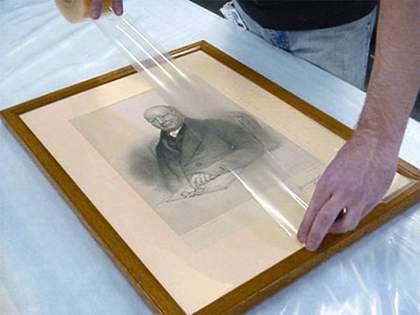
Fig.12
Applying glass tape
© Tate 2005

Fig.13
Diagram showing correct application of glass tape
© Tate 2005
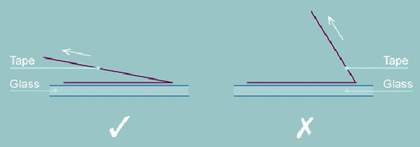
Fig.14
Correct removal of glass tape
© Tate 2005
Cleaning glazing
Some types of glazing, especially glass with low reflective coatings and plastics, can be notoriously difficult to clean. Surfaces may be vulnerable to scratching or have a tendency to smear, and plastics suffer from static. Tape or protective film leave marks on the glazing, which should be removed gently with a soft cloth and a glass cleaning product. Manufacturers should recommend the cleaning method and products most suitable for individual glazing products. A diluted solution of dishwashing liquid and water is a reliable, safe alternative cleaner for glass. Tate Technicians have found that a mixture of commercially available window cleaner containing vinegar (such as Windolene™) works well on the low reflective glass used in-house. Cleaning products with anti-static properties are recommended for cleaning acrylic glazing. For any glazing product, the wiping material, whether of cloth or paper, should be soft, strong and plentiful. Crucially, avoid any product which sheds fibres during the cleaning process. Always apply the cleaning liquid to the cloth rather than to the glazed artwork, or if cleaning glass sheets, allow time for any solvent fumes to evaporate before using them to frame artwork.
Safe framing recommendations
Numerous publications exist on conservation framing and glazing. Safe framing dramatically reduces the possibility of glazing breakage and damage to the artwork (fig.15). The frame should be sturdily constructed to restrict the amount it will flex and also strong enough to accommodate the weight and thickness of the proposed glazing. Where possible, glazing should be spaced away from the object. If a breakage does occur, window mounts help contain broken fragments and offer some protection for the work. The glazing should be cut to fit comfortably (not tightly) in the frame rebate, with a small margin to allow for movement due to thermal expansion. The rebate of the frame should be smooth and clear of any obstructions (protruding tack heads, knots in the timber, etc.). Some type of rebate padding to absorb knocks and protect the glazing from imperfections in the rebate could be considered, for instance rubber gaskets could be assessed in the future. The glazing should be sealed into the frame rebate to protect against dust, using gummed paper tape or, when sealing acrylic glazing, a reliable self-adhesive product such as 3M Magic Tape®. The backing board should be rigid, held in place with regularly spaced framers’ points, brads, nails or other methods of containment, and sealed to the frame with gummed paper tape. Hardboard may be used, isolated from the artwork and mount by a product such as Melinex®. A label on the backing board should specify what glazing has been used, and give any specific care instructions.
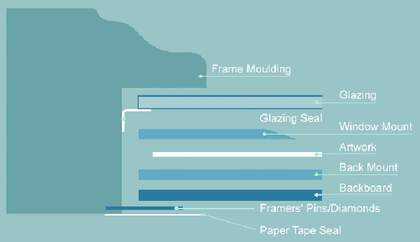
Fig.15
Cross-section of work on paper framed to conservation standards
© Tate 2005
Current glazing procedure at Tate
At Tate, as at many other institutions, glazing procedures have altered considerably in the last two decades, in line with the arrival on the market of new products (eg. acrylic and low reflective laminated glass) improvements in museum practice, changing demands placed upon the artwork, and changing assessments of risk. The aim at Tate in recent years has been to eliminate the need to change glazing for safe travel and to provide consistent, safe glazing which will also be acceptable on display. Below is a summary of the main glazing procedures currently followed for works on paper.15
- Ultraviolet absorbing 3 mm acrylic sheet is still used for the majority of works on paper, both those travelling and those on display at Tate sites. Thicker acrylic (5 mm) is used for frames over 1 metre in either direction.
- Single sheet 4 mm low reflective, water white glass is fitted where it makes a marked difference to the viewing of the work and where the frame is considered sturdy enough to house it. It is most often used for permanently framed works on paper measuring less than one metre in both directions. Some Tate standard frames used for works framed temporarily have also been fitted with low reflective glass.
- For works measuring over one metre in any direction, laminated, 4.4 mm low reflective water white glass is used where appropriate.
- As a rule, single sheet glass on works belonging to Tate is not taped for travel. If the work does not belong to Tate, or where the highest standards of framing, handling and transport cannot be ensured taping may be carried out.
- Tate policy and procedure on handling, framing, wrapping, crating and transporting all works are strictly adhered to.16 Small sturdy frames not being crated for transport are padded at the corners or soft wrapped with Jiffy foam (polyethylene foam) or a similar product and sealed in polythene. More frequently, larger works are being fitted with transit frames. Crates are made to stringent specifications.17 Works travelling abroad and works travelling with an independent carrier within Britain often receive an additional layer of packing protection. For example, when using the Tate vehicle and art handlers in domestic situations, works often travel uncased (soft wrapped or wrapped in their transit frames) and small works might travel padded and wrapped in slotted trolleys but when going by air, on tour, or sometimes when travelling with an independent carrier within Britain, works will also be cased.
Conclusion
The key to choosing the right glazing for works of art is to be familiar with the requirements of the artwork, to understand the demands that will be placed on the object, and to have up to date knowledge of the glazing alternatives available. Ultraviolet absorbing acrylic glazing remains the most viable option for large groups of works on paper temporarily framed for exhibition, loan or display. Modified versions of both plastic and glass should also be considered when selecting glazing on an individual basis. Testing and experience at Tate show that glass is much safer than expected, provided museum procedures are of an acceptably high standard and the frame is constructed adequately. Inevitably, the performance and safety of any glazing is only as good as the quality of the framing, packing, handling and transportation to which the glazed work is subjected.

